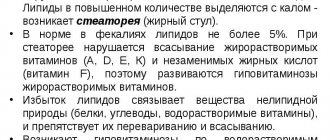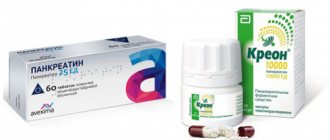General inspection
At this stage, the doctor detects the following signs of gastrointestinal ailments:
- Weight loss. It is due to the fact that the patient deliberately limits food in order to avoid pain after eating. Ulcer sufferers, especially men, are often asthenic, that is, excessively thin.
- Pale skin (often sticky, cold sweating) indicates obvious/hidden ulcerative bleeding.
- Gray, sallow skin. This sign may indicate stomach cancer.
- Scars on the abdomen from previous operations on the digestive tract.
The abdominal wall is also examined directly (provided there is good lighting). For example, if its movement “lags behind” during diaphragmatic breathing, this is regarded as a sign of a local inflammatory process of the peritoneum.
Palpation of the abdomen: results
Using this research method, a specialist determines the exact location of the stomach, its density and smoothness of the surface. It is very important to clearly identify the exact boundaries of the organ, the intensity of the discomfort experienced by the patient, as well as the degree of tension in his abdominal muscles.
If the greater curvature of the stomach is palpated and the doctor notes that it is significantly thickened and the person feels pain, then gastritis or an ulcer cannot be ruled out.
The shape of the organ is also important. An increase in its lower border indicates overcrowding, increased intra-abdominal pressure, expansion or displacement.
If the presence of cancer is suspected, then the outline and density of the stomach changes dramatically. Individual thickenings can be felt on its walls. They are especially noticeable when the patient is standing. Percussion palpation is also used. It determines the degree of splashing in the organ. Normally it is present after eating. If a person has not eaten anything, then this sign indicates that the motor functions of the organ are impaired, and the evacuation ability is reduced.
Typically, such changes indicate the presence of spasms or stenosis of the pylorus, the formation of scars or adhesions, the occurrence of a neoplasm or hyperfunction of the internal glands.
Methods of palpation of the stomach
According to medical prescriptions, the technique of palpation of the abdomen is carried out in strict sequence. Its purpose is to assess the condition of the anterior abdominal wall, cavity organs, and identify pathologies. This examination is carried out on an empty stomach, the intestines must be emptied. The patient is placed on his back on the couch.
Superficial
This procedure will allow you to decide:
- size, shape of the palpable part of the stomach, nearby organs;
- tension of the abdominal muscles (under normal conditions it should be insignificant);
- localization of pain, which makes it possible to make a preliminary diagnosis in acute processes (for example, a hard, painful abdomen, muscle tension on the right side - appendicitis).
Superficial palpation is carried out by lightly pressing the flat fingers of one hand on the abdominal wall in certain areas. They start on the left, in the groin area, then move the hand 5 cm above the initial point, then move to the epigastric, right iliac region. The patient should lie relaxed, with his arms at his side, and answer the doctor’s questions about his feelings. This method is called indicative superficial palpation.
There is also comparative superficial palpation. It is carried out according to the principle of symmetry, examining from the right and left:
- iliac, periumbilical region;
- lateral sections of the abdomen;
- hypochondrium;
- epigastric region.
The linea alba is also checked for hernias.
Deep (methodical) sliding
The technique is:
- the fingers, slightly bent along the middle phalanx, are placed in a position parallel to the organ that is being examined;
- form a fold of skin,
- As the patient exhales, the hand gradually sinks deeper into the abdominal cavity;
- the doctor's fingertips slide along the back wall of the abdomen, the organ being checked (this is how mobility is established, painful
With the sliding palpation method, the intestines, stomach, sphincter
, and structure are felt.
During this examination, the doctor sequentially feels:
- intestines (sequence - sigmoid, rectum, transverse colon),
- stomach;
- pylorus (sphincter separating the stomach and the ampulla of the duodenum).
It is also recommended to carry out deep sliding palpation while the patient is standing. Only in this way can one feel the lesser curvature and highly located neoplasms of the pylorus. Deep sliding palpation in half of the cases (in patients with normal position of the organ) makes it possible to check the greater curvature of the stomach, in a quarter of cases - the pylorus.
Why is palpation done?
If you feel persistent pain in the abdominal area that does not go away for a long time, immediately seek help from a doctor. The sooner the doctor examines your stomach, the more likely it is to avoid negative consequences in time.
At your doctor's appointment, you will be asked to bare your stomach. The doctor must see all its departments. The first thing he will pay attention to is the symmetry of its halves, the presence of any protrusions (hernias) and visible peristalsis (contractions of the walls of internal organs).
Next, the doctor needs to find out the cause of your pain. For this purpose, palpation of the abdomen is performed.
This procedure consists of diagnosing the organs located in the abdominal cavity, the cavity itself and the peritoneum by palpating with the hands through the skin.
By palpation, the doctor diagnoses the area whose condition is deviated from the norm, determining further actions in the direction of treating the patient. Through this examination procedure, the doctor can clearly identify the cause and source of abdominal pain.
Ausculto-percussion, ausculto-affriction
The essence of these two methods is similar. The goal is to determine the size of the stomach and find the lower limit. Normally, the latter is located slightly above the navel (3-4 cm in men, a couple of cm in women). The patient is placed on his back, and the doctor places the phonendoscope in the middle between the lower part of the sternum and the navel. During ausculto-percussion, the doctor uses one finger to apply superficial blows in a circular direction relative to the phonendoscope.
With ausculto-affriction, the finger is not “hit”, but is drawn along the abdominal wall and “scraped” it. While the finger “goes” over the stomach, in phonendosco
Using this technique, the size of the stomach is determined
no rustling is heard. When it goes beyond these limits it stops. The place where the sound disappeared indicates the lower border of the organ. From here, the specialist carries out deep palpation: bending his fingers and placing his hand in this area, he feels the abdomen along the midline. The solid formation here is a tumor. In 50% of cases, a greater curvature of the organ is felt under the fingers (a soft “roller” running transversely along the spine).
Pain when palpating the greater curvature is a signal of inflammation, an ulcerative process.
Performing an abdominal examination
An abdominal examination can be either preventive (routine medical examination) or unscheduled in case of patient complaints.
The procedure for examining the abdomen of an adult is somewhat different from examining the abdomen of a child. This is due to the fact that the organs located in the child’s abdominal cavity are smaller, more closely adjacent to each other, and more susceptible to external stimuli.
In an adult
An examination of the abdominal cavity of an adult is carried out exactly as described above. First, the doctor visually assesses visible deviations from the norm, then proceeds to superficial palpation.
The next step is deep palpation, which allows a more detailed assessment of the condition of the organs located in the abdominal cavity (and the cavity itself).
It is worth noting that in people with developed muscles, palpation can be very problematic.
Sometimes this procedure may simply not make sense.
In children
The anatomy of a child's abdominal cavity differs slightly in the location and size of the internal organs. The liver in children extends beyond the right hypochondrium, which simplifies the diagnostic procedure. The pancreas is located somewhat deeper than in adults. The gallbladder is not palpable at all.
Children are more likely to experience an enlarged abdomen with accompanying pain caused by flatulence and obesity.
It is necessary to take into account the psychological characteristics of the child. Children cannot always admit whether something hurts them, and sometimes they can exaggerate. Therefore, in this case, the doctor must be more scrupulous and rely more on his own experience and knowledge.
Splash noise detection
Examination of the stomach by shaking it (succussion) is done to identify the presence of fluid in the organ. In this case, the subject needs to lie on his back, he is asked to breathe calmly, deeply, and the stomach must be involved in the breathing process. The doctor, with 4 half-bent fingers of his right hand, makes quick, short pushes into the epigastric region. With your left hand, you fix the abdominal muscles in the lower part of the sternum (xiphoid process). The presence of liquid in the stomach causes a gurgling sound - a splashing sound.
Thus determine:
- the lower border of the organ is the “extreme”, lowest point where this specific sound is still heard;
- tone: the presence of splashing noise on an empty stomach (7-8 hours after the last meal) suggests stagnation of the contents, that is, a failure of the evacuation function or an increase in the secretory function (less common); the absence of this already 60 minutes after eating, on the contrary, may indicate an acceleration of motor-evacuation ability.
Inspection, palpation and auscultation of the intestines. Pathological symptoms, diagnostic value
The abdomen in patients may be enlarged due to the accumulation of fluid due to ascites or excessive development of subcutaneous fat, flatulence (accumulation of gases). A flat, tense or even retracted abdomen indicates diffuse peritonitis. Abdominal asymmetry occurs with intestinal obstruction, and above the site of obstruction, the intestinal loops are dilated due to the accumulation of gases in them, and below they are in a collapsed state. Asymmetry can be caused by hepatomegaly or splenomegaly, the presence of advanced large tumors of the abdominal organs.
Examination of patients with intestinal diseases reveals a decrease in body weight associated with the presence of malabsorption syndrome (malabsorption). It may be hereditary or acquired.
The acquired syndrome accompanies a state of dysbiosis (imbalance between pathological and saprophytic intestinal microflora) or chronic inflammatory diseases of the small intestine. The syndrome is manifested by a decrease in body weight, trophic disorders as a result of a lack of vitamins (dry skin, fragility, dullness of nails and hair), signs of osteoporosis, and visual impairment. Gastroenterogenic iron deficiency anemia occurs very often. Characterized by increased frequency of stools, a tendency to loose stools, steatorrhea (increased fat content in stool), creatorrhoea (increased content of undigested fiber). Upon examination, the presence of hernias, striae, and scars on the anterior abdominal wall is determined. Striae develop with a rapid significant increase in weight, disease, or Cushing's syndrome and are purple stripes of skin stretching. Scars provide information about a history of trauma or surgical interventions on the abdominal organs. Hernias can be postoperative, umbilical, or white line of the abdomen.
Palpation. First superficial, and then deep methodological according to the Obraztsov-Strazhesko method.
Percussion over the intestines mainly produces a tympanic sound. The appearance of a dull sound indicates the presence of free fluid in the abdominal cavity (ascites); it usually accumulates in the sloping parts of the abdomen. A change in percussion sound to dull indicates the presence of a pathological focus (cysts, tumors). A positive wave symptom indicates the presence of ascites. When you place the palm of one hand on the side of the abdomen and apply pushing movements with the palm of the other on the opposite side, the sensation of a wave of liquid indicates a positive interpretation of the symptom.
Auscultation. Noises arising from peristaltic movements of the intestine can be easily auscultated using a phonendoscope. Increased peristalsis, often audible at a distance, is caused by intestinal diseases (inflammatory diseases accompanied by hyperkinetic changes in motor function or intestinal obstruction). It is characteristic that at the early stage of obstruction, increased peristalsis is heard, and then it is replaced by its complete absence (a symptom of deathly silence). Another pathological noise is the peritoneal friction noise, which occurs as a reaction of the peritoneum to inflammatory diseases of the abdominal cavity, accompanied by the deposition of fibrin on it.
LECTURE No. 26. Objective study of patients with diseases of the gastrointestinal tract. Examination, percussion, palpation of the stomach, pathological symptoms
Objective study of patients with diseases of the gastrointestinal tract
The general condition of patients with uncomplicated diseases is satisfactory. The development of bleeding and perforation of the ulcer cause pain of significant intensity, forcing patients to lie in bed. Examination of patients with stomach diseases reveals a decrease in body weight associated with conscious restriction of one’s diet if food intake provokes pain (for example, with peptic ulcers, pyloric stenosis or decreased appetite), which is very typical for patients with stomach cancer. Patients with peptic ulcer disease, as a rule, have an asthenic body type; men are more often affected. Examination allows you to determine the pallor of the skin in chronic posthemorrhagic anemia associated with a bleeding ulcer, and the bleeding can be either hidden or obvious. Examination of patients with bleeding reveals pallor and cold, sticky sweat. Patients with stomach cancer may have, in addition to pallor, a gray, sallow skin tone. Examination of the abdomen reveals scars from previous surgical interventions on the gastrointestinal tract. Significant wiping of a certain area of the abdomen combined with significant weight loss is a sign of a malignant tumor.
Percussion of the stomach. This is done using quiet percussion. It is possible to determine the lower border of the stomach, gas bubble of the stomach (Traube space). Traube's space is well defined on an empty stomach and decreases after eating. If it is determined to be insignificant on an empty stomach, then the presence of a stomach tumor or pyloric stenosis may be present. When percussing the stomach, a tympanic sound is determined, lower than when percussing the intestines.
Palpation of the stomach. Both superficial indicative and deep methodical palpation according to Obraztsov-Strazhesko are carried out.
Superficial palpation helps to identify tension in the muscles of the anterior abdominal wall, the Shchetkin-Blumberg symptom, the divergence of the “weak zones” of the anterior abdominal wall, and allows you to determine the greater curvature of the stomach, which is located in the epigastric region 2 cm above the level of the navel. Pain on palpation in the epigastric region is a sign of gastric ulcer. The pylorus of the stomach is palpated in the epigastric region on the right, 3 cm above the navel, like an elastic cylinder, rumbling. When palpating the pylorus, its stenosis is sometimes determined as a result of cicatricial changes in this area. In this case, the consistency of the pylorus becomes dense, and the volume of the stomach increases, which is determined by the displacement of its lower border. Tumors of the stomach wall with exophytic growth are defined as dense, tuberous formations, possibly adherent to the underlying tissues.
Auscultation. The auscultafraction method allows you to determine the lower border of the stomach. To do this, the phonendoscope is placed at the supposed center of the organ, under the left costal arch, and then, with clumsy movements of the nail, it is approached towards the organ. The moment of sound appearance corresponds to the border of the organ, determined by the level of the finger.
Methods for examining the stomach
X-ray examination. Allows you to evaluate the motor and evacuation function of the stomach. The study is carried out using a contrast agent - barium sulfate, which is filled with the stomach, and then a series of images are taken. The size and shape of the stomach (stomach enlargement can sometimes be associated with the presence of pyloric stenosis), and peristaltic waves are assessed. The mucous membrane is normally folded; smoothing of the clutches occurs during atrophic processes (gastritis). The niche symptom (deepening of the mucous membrane filled with contrast) is a sign of a stomach ulcer. Converging folds are usually located opposite it - a symptom of a pointing finger . A filling defect occurs when polyps grow on the wall of the stomach. Malignant tumors are manifested by the appearance of breakage of folds. These areas are rigid and do not peristalt. Sometimes it is possible to determine gastroesophageal reflux, the leading symptom of gastroesophageal reflux disease.
Endoscopic examination. It is carried out using a special gastroscope. Endoscopic examination allows us to assess the condition of the mucous membrane: erosions, ulcers, their size, number, depth. During the study, it is possible to take a biopsy sample for examination and establishment of a morphological diagnosis. Since HP infection is of great importance in the etiology of chronic gastritis and gastric ulcers, a culture is performed to obtain a culture and study its sensitivity to antibiotics. Currently, the morphological method for determining HP infection and the rapid urease test are widely used.
Study of the secretory function of the stomach. This study is carried out using a probe examination of gastric juice. After preliminary anesthesia of the pharynx, a thin probe is inserted into the stomach.
With its help, a portion of gastric juice is obtained in the stomach on an empty stomach. Then, at regular intervals, gastric juice is extracted (this is basal secretion). After 1 hour, a test breakfast is introduced - meat broth, cabbage broth, histamine, pentagastrin (has the advantages of histamine and is free of its disadvantages). The resulting portion of gastric juice represents stimulated secretion. A portion received on an empty stomach, basal, stimulated secretion, is examined. A chemical study of gastric juice makes it possible to determine the amount of total and associated acidity.
Palpation of the stomach: technique, norm and deviations. Anatomy of the stomach
Palpation of the stomach is carried out at the initial phase of examination of the gastrointestinal tract. The procedure refers to physical methods of examining a patient.
Palpation is carried out if there are problems with the digestive tract; the method allows you to determine the presence of hernias, neoplasms or cysts.
There are four types of palpation, which differ in the sequence of examination of the abdominal cavity and the intensity of manual pressure.
Particular attention should be paid to the palpation procedure performed on children, because the skin of young patients is very delicate and sensitive.
Anatomy of the stomach
The stomach is an extension shaped like a bag, designed for temporary storage and partial digestion of ingested food. It performs important functions. The length of the organ reaches 20-25 cm, volume – 1.5-3 liters. The size and shape of the stomach are determined by its fullness, the age of the patient and the condition of the muscle layer.
The stomach is located above the epigastrium, most of it to the left of the middle plane, and 1/3 to the right of it. The organ in its normal physiological position supports the ligamentous apparatus.
The wall of the stomach consists of three layers, each of which has a specific structure. The gastric walls are protected by an inner epithelial layer - the mucous membrane. Beneath it there is submucosal adipose and epithelial tissue, including capillaries and nerve endings. It contains glands that produce stomach secretions, mucus and peptides.
Food enters the stomach through the esophagus and is digested under the influence of gastric juice and hydrochloric acid over a period of 2-6 hours. Then, thanks to periodic muscle contractions, the food bolus moves to the outlet and is pushed out in portions into the duodenum.
Norm and deviations
Normally, the stomach is located on the left side of the body, but systematic overeating can cause it to shift to the abdominal area of the organ. Near the esophageal opening and the transition to the duodenum there are muscle thickenings in a circular shape. They prevent food from entering the esophagus.
When the functions of the alimentary valve are impaired, gastric contents are thrown into the esophagus, causing heartburn. Damage to the sphincter causes bile and pancreatic juice to enter the stomach or, conversely, acidic contents to leak into the intestines, which leads to irritation of the stomach walls and ulceration.
Normally, the position of the cardia is determined on the frontal wall of the abdomen in the area of 6-7 ribs. The vault or fundus of the stomach reaches the fifth rib, the pylorus reaches the eighth rib. The lesser curvature is located below, to the left of the xiphoid process, and the greater projection runs arcuately from the fifth to the eighth intercostal space.
Depending on the specific body type, specific shapes and types of the human stomach are distinguished:
- Horn or cone shape. They occur when a person has a brachymorphic physique. The stomach has an almost transverse arrangement.
- Fish hook shape. Typical for patients with mesomorphic build. The body of the stomach is located vertically, then bends sharply to the right side, forming an acute angle between the evacuation route and the digestive sac.
- Stocking shape. It is recorded when the patient has a dolichomorphic physique. The descending zone of the stomach is low, and the pyloric part is raised steeply, located along the midline or slightly to the side of it.
These forms are inherent to a body in an upright position. When a person lies on his side or back, the shape of the stomach changes. That is why the palpation procedure is carried out in a supine position in order to obtain the correct clinical picture characterizing a certain pathology.
Deviations from these norms and changes in the size of the stomach, as well as displacement of the organ, indicate the presence of pathological processes and may be symptoms of a specific disease.
When is palpation performed?
Indications for the procedure are cysts, tumors of various origins, hernias, organ displacement, obesity, and inflammatory processes. The patient may complain of increased flatulence, stomach pain, and a clinical picture of appendicitis may be observed.
During the initial examination, the doctor also records weight loss in patients associated with food restriction, to clarify the presence of pain after eating, pallor of the skin, indicating hidden ulcerative bleeding, or grayness of the skin, which is a symptom of stomach cancer.
Approximate inspection
An indicative examination helps determine the tone of the muscle fibers of the stomach and the possibility of resistance of the organ in painful areas. This type of examination allows you to get a picture of the condition of the organs in the abdominal cavity.
Auscultoaffriction is used - light percussion with line movements of the finger. Palpation is carried out counterclockwise, by pressing and circular movements.
Examination of the small circle of the gastrointestinal tract (around the navel) allows you to clarify the diagnosis. By palpation, the gastroenterologist identifies areas of pain and inflammation. With gastritis, palpation of the stomach causes severe pain, since its walls are inflamed, and even superficial tingling can increase the pain.
Comparative method
The method is used to diagnose symmetrical zones of the abdominal cavity and examine the epigastric area. The procedure allows you to determine the correct location of the organ and deviations in its size from the norm, if any anomalies exist.
The procedure is performed from the lower abdomen, comparing the iliac areas. The diagnostic process includes examination of the navel and groin area. The comparative type of palpation differs in the technique of the procedure.
During palpation, the patient is in a sitting position, which makes it possible to identify pathological changes in the abdominal walls.
The procedure makes it possible to determine whether the stomach is in the right place and what the degree of change in the size of the organ is.
Superficial palpation
In the presence of a pathological condition, palpation is accompanied by pain.
The procedure allows you to determine the size and shape of the stomach, the level of tension in the abdominal muscles (under normal conditions it should be insignificant), detect pain points and the lower border of the stomach.
The method helps to make a tentative diagnosis of appendicitis with a painful abdomen and muscle tension on the right side.
The procedure begins on the left, in the groin area, after which the hand is moved to the epigastric area, to the right iliac region. The patient's position is lying down, arms should be at their sides.
Throughout the procedure, the doctor checks with the patient exactly where he feels pain in the stomach upon palpation.
Deep sliding
The examination is scheduled after a visual examination. The procedure is carried out with the fingers slightly bent along the middle phalanx, which are placed parallel to the stomach. As the patient exhales, the hand slowly plunges into the abdominal cavity, the doctor’s fingertips slide along the back wall of the stomach, which helps to establish mobility, pain and structure of the organ.
You need to exhale 2 to 4 times per press from the doctor. Deep palpation of the stomach is carried out starting from the intestine and ending with the pylorus. When pain appears, their nature and location are determined.
During the procedure, the position of the organs relative to each other, their sizes and the possibility of displacement, the nature of the sounds, the presence of seals or tumors are also recorded by determining the lower border of the stomach.
The procedure can also be performed while the patient is standing. In the vertical state, it is possible to feel the lesser curvature and highly located neoplasms of the pylorus.
Ausculto-percussion, ausculto-affrication
The purpose of these examinations is to determine the size of the stomach and its lower border. During ausculto-percussion of the stomach, the doctor, using one finger, makes superficial blows in a circular motion relative to the phonendoscope.
During ausculto-affrication, a finger is passed along the abdominal wall, making raking movements. As long as the finger passes over the stomach, noise is heard in the instrument; when it goes beyond these boundaries, the rustling stops.
The area where the noise has disappeared indicates the lower limit. From this point the doctor begins to do deep palpation. Detection of a hard stomach on palpation indicates a tumor.
Very often, a large curvature of the epigastrium is felt under the fingers.
Percussion
The manipulation is carried out by superficial finger strikes, starting from the navel and moving towards the lateral areas of the abdomen. The patient is placed on his back. The method makes it possible to determine Traube's space, that is, the presence of a gas bubble at the bottom of the epigastrium. Palpation of this type is carried out on an empty stomach; if the volume of gas on an empty stomach is insignificant, a preliminary diagnosis of pyloric stenosis is made.
This method also detects the presence of fluid in the stomach. The patient is asked to lie on his back. The doctor also asks the patient to breathe deeply, involving the stomach in the breathing process.
The gastroenterologist makes quick, short pushes in the epigastric zone with four half-bent fingers of his right hand. With his left hand, the specialist fixes the abdominal muscles in the lower region of the sternum. If there is liquid in the stomach, a gurgling sound appears.
The procedure makes it possible to determine the lower border of the stomach and the tone of the organ.
Specifics of palpation in children
To perform the procedure on infants, the following requirements must be met:
- the child should lie on his back, the baby’s muscles should be relaxed;
- Before performing the procedure, the doctor needs to warm his hands;
- If pain appears, to which the child reacts by crying, the procedure must be stopped immediately.
The palpation procedure allows you to determine the lower border of the stomach in young children, as well as identify the syndrome of the greater curvature of the stomach. It is necessary to pay attention to the thickness of the child’s skin and muscle elasticity.
Diagnosis in children begins with the stomach area and ends with the navel, where the intestines are palpated. Palpation of the stomach is an important link in the process of diagnosing gastrointestinal diseases. Correct implementation of the procedure allows you to make an accurate diagnosis and promptly begin treatment therapy.
Source: https://FB.ru/article/463427/palpatsiya-jeludka-tehnika-vyipolneniya-norma-i-otkloneniya-anatomiya-jeludka











